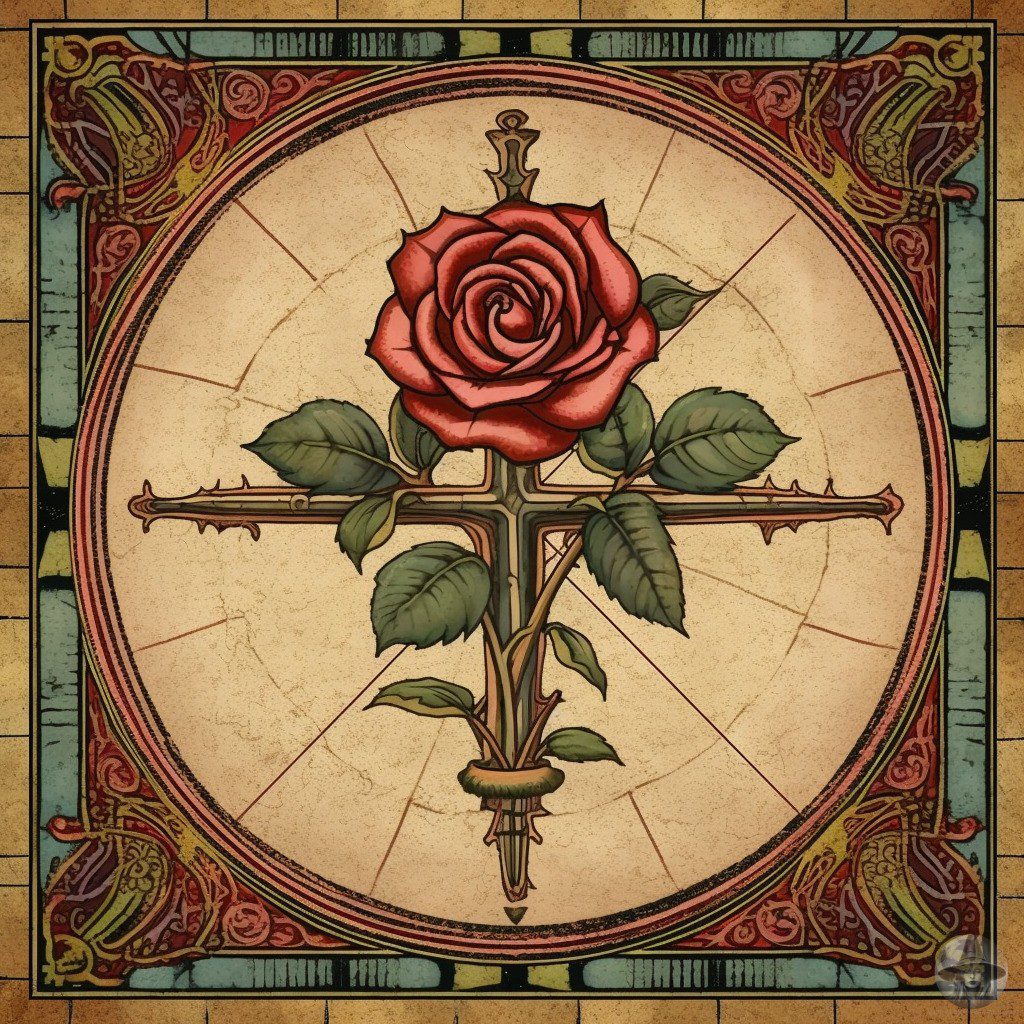Let's embark on a journey into the heart of Rosicrucianism (pronounced roh-zi-kroo-shuh-niz-uh m) , a spiritual society cloaked in mystique and allure. Born amidst the cobblestone streets of late medieval Germany, this clandestine fraternity dedicated their lives to the exploration of ancient mystical, philosophical, and religious doctrines, seeking to adapt these profound insights into everyday existence. Signified by the Rose Cross or Rosy Cross, a cross graced by a rose at its heart, the Order of Rosicrucianism encapsulates myriad traditions, meanings, and layers of symbolism as diverse and complex as the petals of a blooming rose.

The spark that ignited the Rosicrucian flame can be traced back to three mysterious manifestos that emerged from Germany between 1607 and 1616. These documents, known as the "Fama Fraternitatis RC," the "Confessio Fraternitatis," and the "Chymische Hochzeit Christiani Rosencreutz," spun a fascinating legend around a German doctor and mystical philosopher. The man initially referred to as "Frater CRC" was later unveiled as Christian Rosenkreutz, a name that translates to "Rose Cross."
![Count_of_St_Germain[1] Count_of_St_Germain[1]](https://i0.wp.com/ancientpathwayswitchcraft.com/wp-content/uploads/2023/05/count_of_st_germain1.jpg?fit=505%2C632&ssl=1)
Born amidst a cloud of intrigue in 1378 and supposedly living until 1484, Rosenkreutz journeyed far and wide, learning the secrets of alchemy and esoteric wisdom from various masters in the Middle East. Returning to his German homeland, he established the secret order known as the Fraternity of the Rose Cross. This brotherhood of committed individuals pledged to heal the sick without seeking compensation, uphold the clandestine fellowship for a century, convene annually at a temple known as the Spiritus Sanctus, and find a successor before their passing. The Fraternity claimed possession of occult powers and the keys to enlightenment, prophesying a future reformation and a return to grace, all while employing the symbolic language of alchemy to express their mystical doctrines.
There are whispers that Rosenkreutz might be a pseudonym for a prominent historical figure, perhaps even Sir Francis Bacon. Whether metaphorical or real, the narrative resonates with the influences of the renowned Hermetic philosopher Heinrich Khunrath of Hamburg and English occultist John Dee. With their bold claims of a secret brotherhood of alchemists and sages preparing to revolutionize Europe's arts, sciences, religions, and political and intellectual landscape, the manifestos sent ripples of excitement throughout Europe, devastated by political and religious wars.
![800px-British_-_Francis_Bacon_-_Google_Art_Project[1] 800px-British_-_Francis_Bacon_-_Google_Art_Project[1]](https://i0.wp.com/ancientpathwayswitchcraft.com/wp-content/uploads/2023/05/800px-british_-_francis_bacon_-_google_art_project1.jpg?fit=800%2C1032&ssl=1)

![800px-John_Dee_Ashmolean[1] 800px-John_Dee_Ashmolean[1]](https://i0.wp.com/ancientpathwayswitchcraft.com/wp-content/uploads/2023/05/800px-john_dee_ashmolean1.jpg?fit=800%2C800&ssl=1)
This hierarchical secret society, composed of various inner circles, signs of recognition, and alchemical treatises, held considerable sway over Anglo-Saxon Masonry. Its influence led to the creation of the Grand Lodge in 1717, and some even claim that Rosicrucian leaders were the architects of Freemasonry, possessing exclusive knowledge of the hidden meanings within Masonic symbols.
The history of the Rosicrucian Order, however, takes many forms. According to the "Golden and Rosy Cross" secret society, the Rosicrucian Order was founded in AD 46 when an Alexandrian Gnostic sage named Ormus and his six followers were converted by Mark, a disciple of Jesus. This conversion supposedly gave birth to Rosicrucianism as it blended Egyptian mysteries with the emerging teachings of Christianity. Consequently, they adopted the symbol of a red cross surmounted by a rose.
The emblem of the Rose Cross, a radiant golden cross with a red rose at its heart, may hint at Christian connotations. However, the rich tapestry of Rosicrucian writings also reveals elements drawn from various faiths, including the Jewish tradition of Kabbalah. More intricate versions of the Rose Cross symbol feature many colors, Greek, Roman, and Hebrew letters, numerology, and astrological and alchemical symbols – a testament to Rosicrucianism's profound and multi-layered symbolism.
Today, the Rosicrucian Tradition is a patchwork of many different and diverse groups, each lending its own interpretation and focus to the doctrine. These groups can be broadly classified into three main categories:
First, we have the Esoteric Christian Rosicrucian groups, such as the Rosicrucian Fellowship, the Anthroposophical Society, the Lectorium Rosicrucianum, and the Archeosophical Society. These groups follow Christ and aim to impart esoteric wisdom related to the deeper teachings of Christianity.
Then, there are Masonic Rosicrucian groups, such as the Societas Rosicruciana and the Ancient and Accepted Scottish Rite of Freemasonry. These organizations typically guide their members through a symbolic-initiatic journey or direct study.
Finally, there are Initiatory Rosicrucian groups like the Hermetic Order of the Golden Dawn, the Fraternitas Rosae Crucis, and others. These groups follow a hierarchical structure based on degrees, initiations, and titles.
From the mystical echo of ancient wisdom, Rosicrucianism continues to inspire and guide its followers, much like a rose guides the way with its scent, towards the illumination of spiritual truth. Come along, and let's delve deeper into the Rosicrucian garden, appreciating its complex symbols, ancient wisdom, and enduring legacy.

